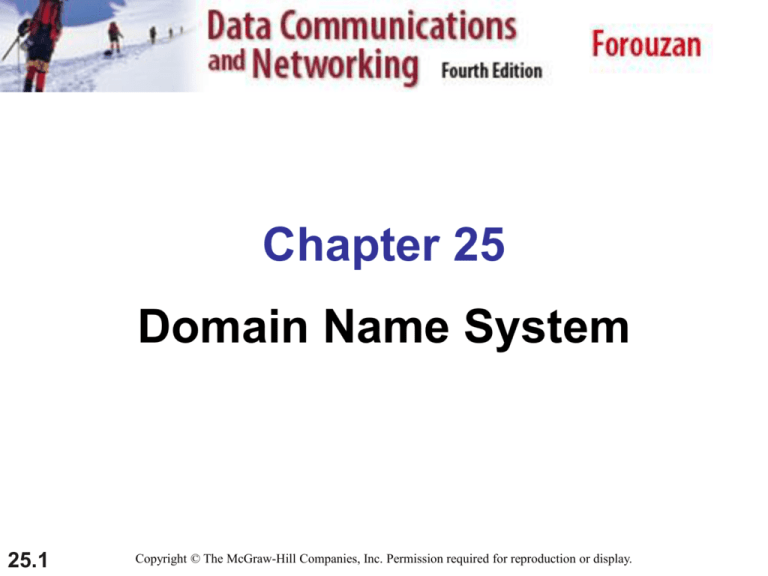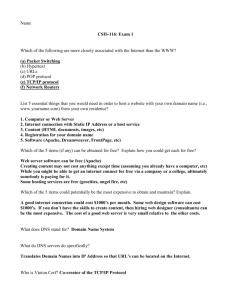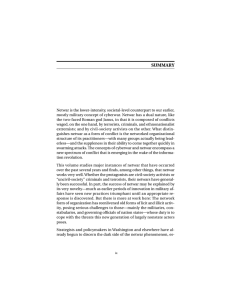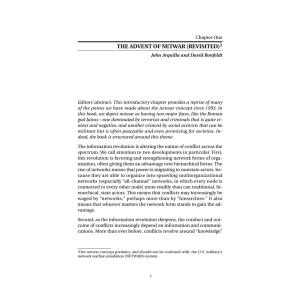ch25
advertisement

Chapter 25 Domain Name System 25.1 Copyright © The McGraw-Hill Companies, Inc. Permission required for reproduction or display. Figure 25.1 Example of using the DNS service server Typo in textbook 25.2 25-1 NAME SPACE To be unambiguous, the names assigned to machines must be carefully selected from a name space with complete control over the binding between the names and IP addresses. Topics discussed in this section: Flat Name Space: hard to manage for large-scale system Hierarchical Name Space: name has several parts 25.3 25-2 DOMAIN NAME SPACE To have a hierarchical name space, a domain name space was designed. In this design the names are defined in an inverted-tree structure with the root at the top. The tree can have only 128 levels: level 0 (root) to level 127. Topics discussed in this section: Label Domain Name Domain 25.4 Figure 25.2 Domain name space root 25.5 Figure 25.3 Domain names and labels 25.6 Figure 25.5 Domains: subtree of the domain name space 25.7 25-3 DISTRIBUTION OF NAME SPACE The information contained in the domain name space must be stored. However, it is very inefficient and also unreliable to have just one computer store such a huge amount of information. In this section, we discuss the distribution of the domain name space. Topics discussed in this section: Hierarchy of Name Servers Zone Root Server Primary and Secondary Servers 25.8 Figure 25.6 Hierarchy of name servers 25.9 DNS: Root name servers a Verisign, Dulles, VA c Cogent, Herndon, VA (also Los Angeles) d U Maryland College Park, MD g US DoD Vienna, VA h ARL Aberdeen, MD j Verisign, ( 11 locations) k RIPE London (also Amsterdam, Frankfurt) i Autonomica, Stockholm (plus 3 other locations) m WIDE Tokyo e NASA Mt View, CA f Internet Software C. Palo Alto, CA (and 17 other locations) b USC-ISI Marina del Rey, CA l ICANN Los Angeles, CA 13 root name servers worldwide TLD and Authoritative Servers Top-level domain (TLD) servers: responsible for com, org, net, edu, etc, and all top-level country domains uk, fr, ca, jp. Network solutions maintains servers for com TLD Educause for edu TLD Authoritative DNS servers: organization’s DNS servers, providing authoritative hostname to IP mappings for organization’s servers (e.g., Web and mail). Can be maintained by organization or service provider (paid by the organization) Figure 25.7 Zones and domains 25.12 Note Two types of DNS server: A primary server loads all information from the disk file; the secondary server loads all information from the primary server. Reason: redundancy When the secondary downloads information from the primary, it is called zone transfer. 25.13 25-4 DNS IN THE INTERNET DNS is a protocol that can be used in different platforms. In the Internet, the domain name space (tree) is divided into three different sections: generic domains, country domains, and the inverse domain. Topics discussed in this section: Generic Domains Country Domains Inverse Domain 25.14 DNS Query Commands Unix: nslookup, dig Windows: nslookup 25.15 Figure 25.8 DNS IN THE INTERNET 25.16 Figure 25.9 Generic domains 25.17 Table 25.1 Generic domain labels 25.18 Figure 25.10 Country domains 25.19 25-5 RESOLUTION Mapping a name to an address or an address to a name is called name-address resolution. Topics discussed in this section: Resolver Mapping Names to Addresses Mapping Addresses to Names Recursive Resolution Caching 25.20 Figure 25.12 Recursive resolution 25.21 Figure 25.13 Iterative resolution 25.22 Caching: Main Reason for the Efficiency of DNS All DNS servers cache prior query results Normal DNS query will not go through the full steps of recursive/iterative resolution 25.23 25-6 DNS MESSAGES DNS has two types of messages: query and response. Both types have the same format. The query message consists of a header and question records; the response message consists of a header, question records, answer records, authoritative records, and additional records. Topics discussed in this section: Header 25.24 Figure 25.14 Query and response messages 25.25 Figure 25.15 Header format 25.26 25-7 TYPES OF RECORDS As we saw in Section 25.6, two types of records are used in DNS. The question records are used in the question section of the query and response messages. The resource records are used in the answer, authoritative, and additional information sections of the response message. Topics discussed in this section: Question Record Resource Record 25.27 DNS records DNS: distributed db storing Resource Records (RR) RR format: (name, Type=A 25.28 name is hostname value is IP address value, type, ttl) Type=CNAME name is alias name for some “canonical” (the real) name www.ibm.com is really Type=NS servereast.backup2.ibm.com value is canonical name name is domain (e.g. foo.com) value is name of Type=MX authoritative DNS server value is name of mailserver for this domain associated with name DNS protocol, messages DNS protocol : query and reply messages, both with same message format msg header identification: 16 bit # for query, reply to query uses same # flags: query or reply recursion desired recursion available reply is authoritative 25.29 DNS protocol, messages (UDP 53) Name, type fields for a query RRs in response to query records for authoritative servers additional “helpful” info that may be used Let’s check a web example using Wireshark! (MX record: nslookup –type=MX cs.ucf.edu or dig mx cs.ucf.edu) 25.30 Inserting records into DNS Example: just created startup “netwar” Register name netwar.com at a registrar (e.g., Network Solutions) Need to provide registrar with names and IP addresses of your authoritative name server (primary and secondary) Registrar inserts two RRs into the com TLD server: (netwar.com, dns1.netwar.com, NS) (dns1.netwar.com, 212.212.212.1, A) Put in authoritative server dns1.netwar.com Type A record for www.netwar.com Type MX record for netwar.com (email) 25.31 Type CName for netwar.com (alias) Type A record for the email server How do people get the IP address of your Web site? 25-8 REGISTRARS How are new domains added to DNS? This is done through a registrar, a commercial entity accredited by ICANN. A registrar first verifies that the requested domain name is unique and then enters it into the DNS database. A fee is charged. 25.32 25-9 DYNAMIC DOMAIN NAME SYSTEM (DDNS) Used when a server has a dynamic-changeable IP The DNS master file must be updated dynamically. The Dynamic Domain Name System (DDNS) therefore was devised to respond to this need. In DDNS, when a binding between a name and an address is determined, the information is sent, usually by DHCP to a primary DNS server. The primary server updates the zone. The secondary servers are notified either actively or passively. 25.33 25-10 ENCAPSULATION DNS can use either UDP or TCP. In both cases the well-known port used by the server is port 53. UDP is used when the size of the response message is less than 512 bytes because most UDP packages have a 512-byte packet size limit. If the size of the response message is more than 512 bytes, a TCP connection is used. 25.34 Note DNS can use the services of UDP or TCP using the well-known port 53. 25.35









